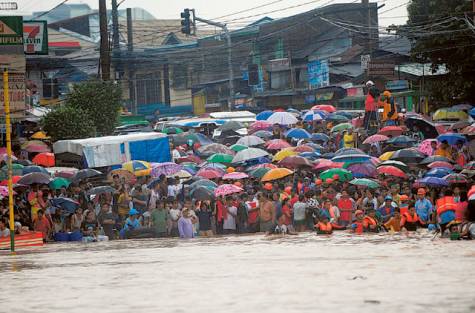
Manila, August 8: Twenty-two people, including seven missing, died as Tropical Storm Haikui, 300 northeast of Taiwan, triggered low pressure areas that drenched northern, central and southern Luzon, Metro Manila and central Philippines with endless rains, resulting in floods and mudflows, and turned two-thirds of the country into a virtual “water-world,” officials said.
Five members of the Baylon family, including Cecille, 40, Jessica, 20, Jinjin, 16, Jason, 7; and a three-week old baby died at the East Avenue Medical Centre where they were rushed after their bodies were recovered from a landslide that buried nine people and five houses in a slum area in Litex, Commonwealth Village, suburban Quezon City, said Undersecretary Benito Ramos, head of the National Disaster Risk Reduction and Management Council (NDRRMC).
Four of those who were unearthed from the mudslide in Litex were found alive, Ramos said, adding that many shanties in slum areas were also damaged by the landslide.
Meanwhile, four drowned in northern suburban Bulacan; two also drowned in southern Luzon's Batangas; and one remained missing after being carried by a surging river in central Luzon's Bataan. The three provinces were hit by floods, Ramos said.
Metro Manila and nearby provinces were paralysed.
All rivers surrounding Metro Manila were swollen. There was high tide after lunch, helping floods to rise and damage more villages and major streets.
The Epifanio de los Santos (EDSA), a major thoroughfare that traverses northern and southern suburban areas was spared from floods and remained passable.
Houses in high-end Provident Villages in eastern suburban Marikina were flooded up to the second floor.
Several families called on TV and radio stations, saying they have been on their rooftops since early morning of Tuesday.
At night-time government agencies had not succeeded in rescuing all the people who were on their rooftops.
Policemen and military men used rubber boats to rescue residents and to give relief assistance.
“Some rubber boats were damaged. Those who gave assistance also fell from their rubber boats because of the rampaging floods,” said a radio report.
A stroke patient almost fell from a rubber boat when he was rescued from his house.
Patients at the University of Santo Tomas (UST) Hospital in Manila were transferred to the fifth floor when the ground floor of the hospital was flooded early morning of Tuesday. The entire university complex was also flooded until night of Tuesday.
Dams in all affected areas reached their critical level, prompting authorities to open several gates which also flooded several nearby areas. Small houses fell one by one in those areas, said a TV report.
Two days of endless rains affected 179,026 families or 808,697 people, said Ramos.
About 543,951 families or 250,200 people were in 85 hastily erected evacuation centres, said Ramos, adding that 49,911 families or 231,508 people have left their homes and stayed with relatives who live on safer grounds.
Quezon City Mayor Herbert Bautista kept knocking at private schools to open their gates and allow homeless people to stay.
The number of dead, missing, and affected families could rise further because the rains ermained unabated until night of Tuesday.
“We will not sleep tonight,” said a rescuer.
About 21 storms ravage the Philippines every year.





Comments
Add new comment